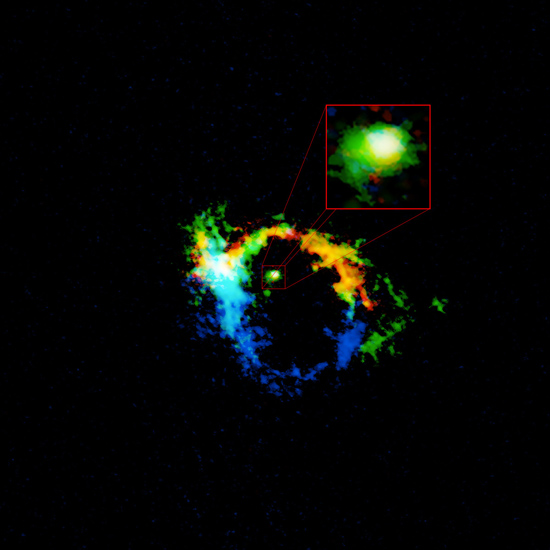ESO | NAOJ | NRAO | ALMA | 2016 Sep 15
Supermassive black holes, millions to billions of times the mass of our Sun, are found at the centers of galaxies. Many of these galactic behemoths are hidden within a thick doughnut-shape ring of dust and gas known as a torus. Previous observations suggest these cloaking, tire-like structures are formed from the native material found near the center of a galaxy.
- ALMA image of the central region of galaxy NGC 1068. The torus of material harboring the supermassive black hole is highlighted in the pullout box. This region, which is approximately 40 light-years across, is the result of material flung out of the black hole's accretion disk. The colors in this image represent the motion of the gas: blue is material moving toward us, red moving away. The areas in green are low velocity and consistent with rotation around a black hole. The white in the central region means the gas is moving both toward and away at very high speed, the conditions illustrated in the artist impression. The outer ring area is unrelated to the black hole and is more tied to the structure of the central 1,000 light-years of the host galaxy. Credit: Gallimore et. al; ALMA (ESO/NAOJ/NRAO); B. Saxton (NRAO/AUI/NSF)
New data from the Atacama Large Millimeter/submillimeter Array (ALMA), however, reveal that the black hole at the center of a galaxy named NGC 1068 is actually the source of its own dusty torus of dust and gas, forged from material flung out of the black hole’s accretion disk.
This newly discovered cosmic fountain of cold gas and dust could reshape our understanding of how black holes impact their host galaxy and potentially the intergalactic medium. ...
NGC 1068 (also known as Messier 77) is a barred spiral galaxy approximately 47 million light-years from Earth in the direction of the constellation Cetus (aka th ‘Whale’). At its center is an active galactic nucleus, a supermassive black hole that is being fed by a thin, rotating disk of gas and dust known as an accretion disk. As material in the disk spirals toward the central black hole, it becomes superheated and blazes bright with ultraviolet radiation. The outer reaches of the disk, however, are considerably cooler and glow more appreciably in infrared light and the millimeter-wavelength light that ALMA can detect.
Using ALMA, an international team of astronomers peered deep into this region and discovered a sprinkling of cool clouds of carbon monoxide lifting off the outer portion of the accretion disk. The energy from the hot inner disk partially ionizes these clouds, enabling them to adhere to powerful magnetic field lines that wrap around the disk. ...
High-Velocity Bipolar Molecular Emission from an AGN Torus - Jack F. Gallimore et al
- Astrophysical Journal Letters 829(1):L7 (2016 Sep 20) DOI: 10.3847/2041-8205/829/1/L7
arXiv.org > astro-ph > arXiv:1608.02210 > 07 Aug 2016
